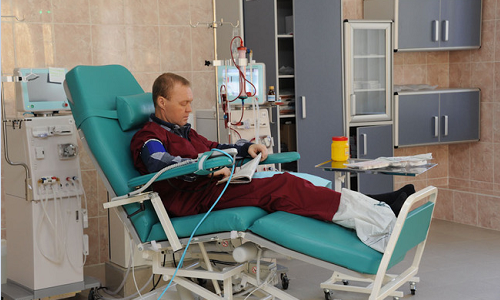Mouse fever in men is more common than in women. This pathology refers to viral diseases. A peculiarity of the disease is its carrier. The bearer of the disease is small rodents. Transmission is carried out from the carrier to products and dust particles. A person can get infected in different ways. This disease is dangerous for the urinary system. The main negative processes occur in the renal pelvis. For this reason, the patient needs urgent hospitalization. If a man does not seek help in a timely manner, a lethal outcome is possible.

Etiology of the disease
Mouse fever has an air-dust transmission pathway. The virus remains in active form in any contamination. Activation of the microorganism occurs when it enters the mucous tissue.
The virus rapidly spreads by blood and causes serious problems in the vascular system. Settling of the pathogen occurs in the renal pelvis. This is what influences the patient's further condition.
The disease is also transmitted through products that have had contact with the carrier. In this case, with incomplete heat treatment, the virus retains its ability to live. Danger and direct contact with the rodent. In all cases it is recommended to visit a specialist.
The cause of murine fever may be the inhalation of dust particles infected with a microbe. This path is often observed in men who have a certain specialty.
Stages of the disease
Mouse fever occurs in several stages. Initially, the disease passes the incubation stage. It has a different duration. Fever can manifest itself after 10-30 days. This depends on the stage of the features of the protective system. With weak immunity the virus develops more actively. If a man has a good protective function, the disease will manifest later.
Many patients do not pay much attention to the first signs of murine fever. They are similar to the usual respiratory ailment. The man raises his temperature, there are catarrhal phenomena. A characteristic of murine fever is a severe headache and the absence of a cough. Further spread of the virus entails the transition of the disease to the oliguric stage.
After the elimination of these symptoms, the patient is restored. To understand what disorders occur, you need to know the characteristics of the stages of the disease.
Prodromal stage
 At this stage, the man begins to complain about certain signs of the disease. The patient's temperature rises. There is a strong chill. There are complaints of headaches and burning in the throat. To exclude fever, you should carefully examine the condition of the skin.
At this stage, the man begins to complain about certain signs of the disease. The patient's temperature rises. There is a strong chill. There are complaints of headaches and burning in the throat. To exclude fever, you should carefully examine the condition of the skin.
The infected person has hyperemia of the skin of the thoracic and cervical spine. Redness of the skin of the face is less common. This is due to sclerotic processes in small vessels. Thanks to the causative agent, the elasticity of the walls of the capillaries decreases. They are partially destroyed. The process is accompanied by a slight reddening of the upper half of the trunk.
The conjunctival membrane should also be studied. A rash appears on the tissue, which is typical for mouse fever. In rare cases, the symptoms of the first stage are similar to meningitis.
Oliguric stage
At this stage, mouse fever affects the kidneys of a man. The main signs of the disease can be established by the daily volume of urine.
In case of problems with the kidneys, the total volume of fluid drastically decreases. There is also a change in the characteristics of urine. It becomes lighter and more transparent.
The daily volume of fluid in a healthy person is from 2 to 3 liters. With oliguria, a significant decrease in these indicators is observed. The average volume can reach 900 ml. In this case, a pathological change in the tissue of the renal pelvis takes place. Accumulation of fluid leads to a general intoxication of the body.
The man has dyspepsia. The patient begins to vomit, there is dry skin. It is also recommended to pay attention to the composition of stool. With murine fever at this stage, small capillaries are destroyed. This entails the appearance of an admixture of blood in the masses. You should know that fever is not characterized by bleeding from the nose or uterus.
Also oligouric stage is characterized by a sharp drop in temperature. The general condition of the patient continues to worsen.
 Complications are severe soreness in the lumbar region. The man begins to experience unpleasant pulling pains when taking a horizontal position. In the process of urination, soreness increases. This causes sleep problems. The patient stops sleeping normally. During the night, he needs several trips to the toilet. Relief after urination does not occur.
Complications are severe soreness in the lumbar region. The man begins to experience unpleasant pulling pains when taking a horizontal position. In the process of urination, soreness increases. This causes sleep problems. The patient stops sleeping normally. During the night, he needs several trips to the toilet. Relief after urination does not occur.
Exacerbation of the disease
Mouse fever causes disruption of the organs at this stage. In this case, the virus spreads throughout the circulatory system. There are serious violations in the work of organs and tissues. The patient has symptoms such as:
- Severe low back pain;
- Reduction of urine volume;
- Occurrence of various bleedings;
- Puffiness of tissues;
- Brain Dysfunction;
- Decreased motor activity.
Increased pain in the lower back occurs at this stage. The patient stops sleeping normally. It is impossible to take a painless situation. There is a sharp deterioration in the work of the kidneys. Accumulation of fluid in the body is accompanied by swelling of the tissues. The patient has swelling under the eyes, swelling of the limbs. However, some patients can not empty the bladder. The urine ceases to be produced.
There is also a decrease in the work of the brain. Difficulty in impulse transmission is accompanied by impaired motor activity and confusion of consciousness. The patient begins to rave. If a man does not receive medical care, his death can be quickly killed.
The doctor also draws attention to the presence of various bleedings from small vessels. All liquids contain an admixture of blood. To establish the stage, it is necessary to conduct a number of diagnostic measures.
Diagnosis of fever
 It is possible to determine the presence of the virus by the composition of the blood. It reveals cells that are designed to instantly remove the virus from the body. Such cells are called antibodies. Also it is necessary to study the quantitative composition of leukocytes. White cells actively multiply against a background of a serious inflammatory process.
It is possible to determine the presence of the virus by the composition of the blood. It reveals cells that are designed to instantly remove the virus from the body. Such cells are called antibodies. Also it is necessary to study the quantitative composition of leukocytes. White cells actively multiply against a background of a serious inflammatory process.
The amount of nitrogen in the blood is also being studied. Mouse fever affects the sharp increase in nitrogen in the bed. Its total number can increase by 10-15 times. This substance causes a strong poisoning of the body. There is a decrease in tissue activity. They cease to form new cells. The fabrics are dying.
Than Disease
Mouse fever causes a disorder in the kidney tissue. The first changes occur due to vascular damage. The kidney ceases to absorb liquid in the usual amount. Further development of the disease has a negative effect on the shell of the organ. Accumulation of a large volume of liquid can lead to rupture. In this case, the person will need surgical intervention.
Also pathology causes changes in the vascular system. At the acute stage, the structure of the walls of the vessels changes. They become brittle and are destroyed. After eliminating the pathology, a man is often diagnosed with varicose veins.
Patient recovery
The main treatment for a man with murine fever is performed in a hospital. The patient must be under 24-hour medical supervision. If complications occur, they are quickly eliminated by medication. It is also necessary to increase the permeability of the kidneys. To do this, the patient is injected with lytic drugs. Only after the normalization of daily diuresis a man is transferred to a general ward. The duration of treatment depends on the stage of the disease. Full recovery of health occurs 30 days after discharge from the hospital.
If signs of the disease appear, promptly call an ambulance. Delay may affect the further recovery of health. Timely treatment can eliminate complications from such a dangerous disease as murine fever.



